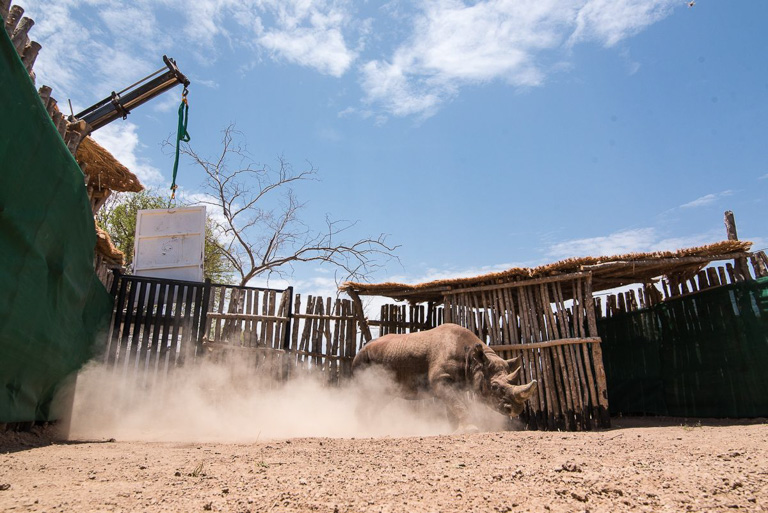- The NGO African Parks and its partners in South Africa and Chad reintroduced six black rhinos to Zakouma National Park on May 4.
- Chad’s oldest national park had not had rhinos since the early 1970s, when they were wiped out by hunting.
- After a brief acclimation period in transitional bomas, or enclosures, the rhinos will be released into a protected sanctuary in the park.
- Around 5,000 black rhinos remain on the African continent, and poaching for their horns, used in traditional Asian medicine, continues to be a threat to their survival as a species.
Zakouma National Park in Chad is now home to six black rhinos, the new set of residents reminiscent of an earlier time for the Central African country’s oldest national park.
“[Friday’s] reintroduction is an important contribution to the long-term conservation of rhinos in Africa, and also to the enrichment of Chad’s natural heritage,” Peter Fearnhead, CEO of African Parks, said in a statement.
African Parks, an NGO that runs parks and protected areas in nine countries, worked with government agencies in South Africa and Chad to ferry two male and four female black rhinoceroses (Diceros bicornis) on a 4,800-kilometer (3,000-mile) airborne journey from Addo National Park in South Africa.

Hunting had wiped out Zakouma’s black rhinos by the early 1970s. Today, rampant poaching across the rhinos’ African range to meet the demand for rhino horn in traditional medicine markets in Asia threatens both of the continent’s rhino species. The IUCN lists black rhinos as critically endangered and white rhinos (Ceratotherium simum) as near threatened species. On May 2, poachers killed three black rhinos, including a calf, at Meru National Park in Kenya. South Africa, where 80 percent of African rhinos live, lost more than 1,000 rhinos in 2017.
“The rhinoceros has survived on this planet for millennia, but with fewer than 25,000 remaining due to the insatiable demand for their horns, they are more affiliated with the prospect of extinction than with survival,” Fearnhead said.
Only about 5,000 black rhinos remain, represented by three subspecies. Now, Chad is one of 11 countries that have wild African rhinos.
After their arrival on May 4 in Zakouma, the six rhinos stepped out of their transport containers into enclosures called bomas that African Parks says will help them gain their footing in their new home. Once the rhinos have acclimated, after perhaps a few days or weeks, the team will release them into “an intensively protected sanctuary within the national park,” the organization said.

Since taking over management of Zakouma in 2010, African Parks said it has worked to bolster law enforcement capabilities and improve local livelihoods, resulting in “the effective elimination of poaching and the recovery of wildlife populations” in the park. Chad’s ambassador to South Africa, Sagour Youssouf Mahamat Itno, credited those changes for making it possible to bring rhinos back to his country.
“It is a mark of the strength of our partnership with African Parks and the transformation of Zakouma in to a secure sanctuary that we are now able to bring rhinos back to Chad where they will receive enduring protection,” Itno said in the statement.
Once the rhinos leave their transitional bomas, they’ll have a team of rangers tasked with keeping them safe, and park staff will also monitor their security from the air, African Parks said.

The 3,049-square-kilometer (1,177-square-mile) national park is part of the Greater Zakouma Ecosystem, an area larger than Belgium. The park is home to lions (Panthera leo), Kordofan giraffes (Giraffa camelopardalis antiquorum) and a growing herd of elephants (Loxodonta cyclotis). Itno said the addition of rhinos to Zakouma could help Chad’s economy, one of the world’s least developed at 186 out of 188 countries, according to 2015 data from the U.N.’s Human Development Index.
“We are resolved to create a secure and prosperous future for wildlife and people, so that generations of Chadians can experience the benefits of healthy and intact natural landscapes,” the ambassador said. “[The rhinos’] reintroduction signifies an important advancement in the restoration of the park, furthering its potential as a conservation area to contribute through tourism to local economies and social development.”

Banner image of a black rhino by John Dickens/African Parks.
FEEDBACK: Use this form to send a message to the author of this post. If you want to post a public comment, you can do that at the bottom of the page.
